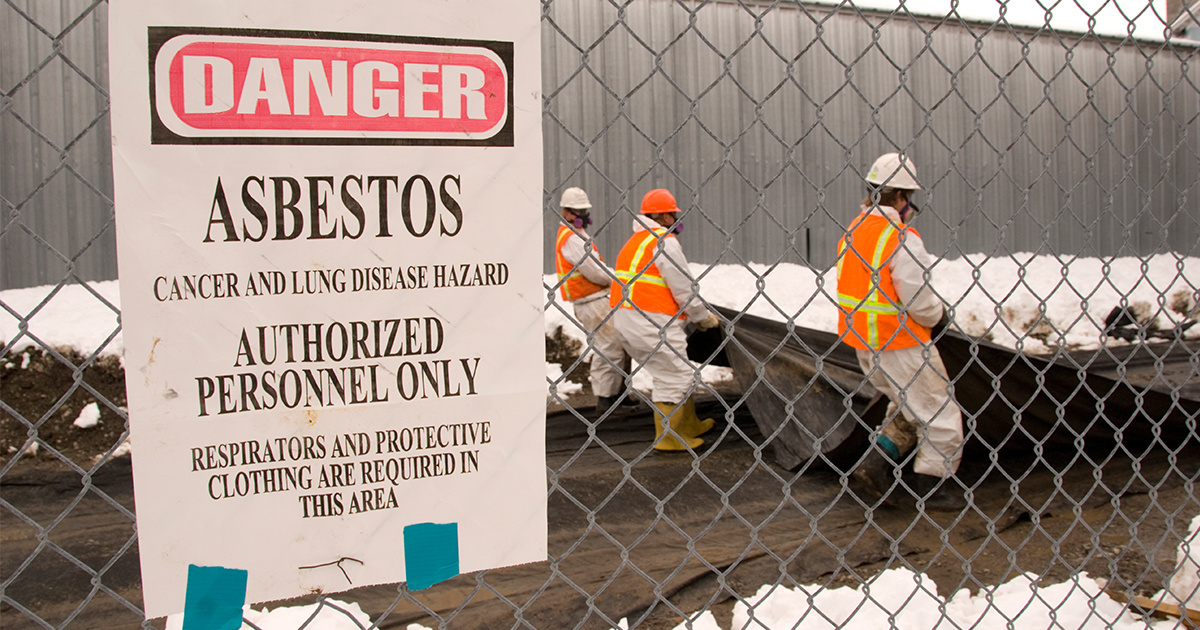

A new EPA rule on asbestos does not say anything about the asbestos currently in the environment. Bob Allen / Getty Images
The U.S. Environmental Protection Agency (EPA) passed a new rule on asbestos Wednesday that it says will “close the door” on new, unapproved uses. But public health advocates warn the rule could actually open the door to increased use of the carcinogenic fibrous material.
The Significant New Use Rule (SNUR) would require any company seeking to manufacture or import asbestos for any of 15 discontinued purposes would need to get the approval of the EPA. The regulation also includes a blanket rule requiring review for “any use of asbestos not previously identified,” The New York Times reported.
“Prior to this new rule, EPA did not have the ability to prevent or restrict certain asbestos products from being reintroduced into the market,” EPA Administrator Andrew Wheeler said in a statement reported by The New York Times.
News: EPA Strengthens Regulation of Asbestos to Close Loophole, Protect Consumers: broad new rule strengthens EPA's ability to rigorously review an expansive list of asbestos products. Prior to new rule EPA did not have ability to restrict certain products https://t.co/V5lcJf5vHN pic.twitter.com/utAkkxVjjJ
— U.S. EPA (@EPA) April 17, 2019
However, some public health advocates worry that the rule creates a mechanism by which companies can introduce new uses of asbestos as long as they get approval.
“This toothless regulation requires companies to seek approval from EPA to resume manufacturing, importing, and processing of asbestos for 15 obsolete uses. It does not ban these uses, but leaves the door open to their return to the marketplace. To think that any company would willingly attempt to resurrect these 15 obsolete asbestos uses is ludicrous. That EPA would enable it is unconscionable,” Asbestos Disease Awareness Organization President Linda Reinstein said in a statement.
ADAO responds to @EPA’s @EPAAWheeler dangerously inadequate new #asbestos #SNUR rule that puts corporate profits ahead of #publichealth and is NOT a ban. https://t.co/5fmuQSC53E #BanAsbestosNow #Mesothelioma
— Linda_ADAO (@Linda_ADAO) April 17, 2019
Reinstein also noted that the rule does not cover existing uses of asbestos, such as its use by the Chlor-Alkiki industry. It also does nothing about the asbestos left in schools, homes and offices from when the material was widely used as an insulator and flame retardant.
Assistant administrator at the EPA’s chemical office Alexandra Dunn told CNN that the agency was still reviewing current uses of asbestos and might propose additional regulations or bans. A few days before the new rule was announced, Wheeler told the House Energy and Commerce Committee he would ban current uses, The New York Times reported, but health advocates like Reinstein argue that Wednesday’s rule does not qualify.
Consumer protection groups have spent a decade lobbying for a law change that would empower the EPA to fully ban asbestos, which kills between 12,000 and 39,275 Americans each year. When an amendment to the Toxic Substances Control Act was finally passed in 2016, requiring the EPA to assess and regulate chemicals and enabling it to do so based exclusively on their health and environmental impacts, advocates hoped a ban was in sight.
Asbestos was added to the first 10 chemicals to be assessed under the amendment, but when the EPA first issued its proposed SNUR in June 2018, advocates were disappointed. Some employees voiced concerns the rule could open the door to new asbestos uses.
The final rule is stronger than the original proposal, The New York Times pointed out, because it requires approval for any new use, not just one of 15 former uses. Some public health advocates do think it is a good start.
“Most of the things coming out of the EPA these days aren’t good,” retired EPA employee and current Environmental Protection Network member Gary Timm told CNN, “but their asbestos work is so well documented.” However, he also thought a full ban would be a logical next step.
Environmental Working Group legislative attorney Melanie Benesh also thought a full ban was in order.
“This new rule makes it more difficult for industry to resume some abandoned uses of asbestos, but that is a half step at best,” Benesh said in a statement. “Administrator Wheeler should use the authority under the new Toxic Substances Control Act law and ban all uses of asbestos. That is the only way the public can trust industry will never again be able to use this dangerous material that has literally killed tens of thousands of Americans.”
Great article by @EcoWatch: Why #Asbestos Is Still a Major Public Health Threat in the U.S. by @orosane. @EPA @EPAAWheeler, Stop Imports and Use. Asbestos Kills. https://t.co/2aJ1vXjEOp
— Linda_ADAO (@Linda_ADAO) August 21, 2018
- Russian Asbestos Company Makes Trump Its Poster Boy - EcoWatch
- EPA Is Failing to Protect School Children From Asbestos, Internal ...
- Career EPA Staff Objected to Trump Administration's Asbestos Plan ...

 233k
233k  41k
41k  Subscribe
Subscribe 